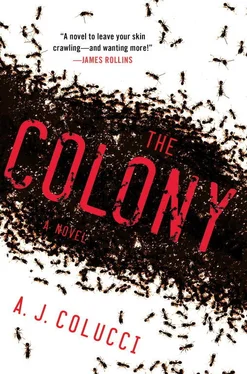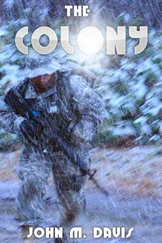All except Sarah.
Instinctively, she dropped to her knees and began to dig Jimmy Porter out. Her fingers were stained with Jimmy’s blood as she clawed through the dirt, but it was useless. His arms disappeared. He sank to his chin. There was a gurgling in his throat right before it swelled shut. When he looked at Sarah, a peaceful expression settled over his face, blood pooled in his eyes and a trickle of pink foam dripped from his nose.
Then Jimmy Porter sank into the earth. Gone.
Sarah rose as the ground vibrated under her feet. She staggered down the steep embankment to the pond, arms turning like windmills to keep her balance. The sky turned dark and the air was suddenly cold. Standing on a rock at the water’s edge, she hugged her waist and clenched her chattering teeth, too terrified to even cry. Behind her, every plant and blade of grass seemed to quiver with life.
They’re coming. They’re going to kill me.
Sarah waded into the freezing water.
Ants can’t swim, they can’t swim.
She continued down a steep decline, taking long strides in the water, boots sloshing through the mud like suction cups. Panic gripped Sarah as the water reached her chest. Imaginary monsters nipped at her hands and elbows.
A thick blob swelled along the shoreline like molten lava, dark and unformed. The creature stretched across the bank under Sarah’s gaze, driving her farther into the pond and filling the air with a strange song.
Kerka kerkosh ker kerkosh kerka kerkosh ker kerkosh .
The sound grew louder, from every direction, and she spun around, unsure where to go. The thing that blanketed the shore was now in the water, cast out wide like a fishing net. It floated across the surface, straight toward her, tiny forms linked together.
Sarah swam under the bridge, taking erratic strokes. The icy water slowed her muscles, froze her lungs, and she sucked in small gasps of air. Faint moonlight beckoned her to the other side of the overpass. She was shivering like mad, but the sound had stopped for a moment. Out of fright, she dove underwater, but a moment later broke the surface.
That’s when the floating beast surged toward her from every shore. She paddled back toward the bridge, teeth chattering so loud she couldn’t hear the strange sound anymore. Her legs retreated sluggishly in the mud until she was directly under the archway, hyperventilating and muttering to herself.
Help me. Oh God, help me.
A black speck fell onto Sarah’s cheek. She peered up at the bridge, no longer able to breathe, and a million ants rained down on her.
“I’VE BEEN DOING QUITE a few experiments but getting nowhere.” Paul stood in front of a glass tank and pried off the lid, releasing the putrid odor of dead rat.
Kendra peered into the tank, holding her breath. Swarms of ants smothered the remaining fur and flesh of a single rodent. They tunneled deep into its guts and black holes that used to be pink eyes.
“Plain-old African Siafu,” said Paul, seeming less repulsed than Kendra. He sealed the lid tight. “As expected, they killed their prey in minutes. So what about this new species—Siafu Moto? Since I’m using rats in my experiments, we should get the same reaction.”
He snatched an empty plastic tank off the counter, strolled to the back of the lab and stooped down in front of a small knee-high door. When he opened the latch, another pungent smell wafted into the room: cedar chips and food pellets. Inside the closet were a couple of metal cages filled with common white lab rats. He chose a fat one that nearly bit him before he dropped it into the tank.
“ Rattus Norvegicus, ” he said. “A nice juicy one.”
Paul brought it back to the counter and picked up a bottle of brown ants. He unscrewed the lid, dangling the bottle over the tank. “Now here’s what happens when you introduce a yummy meal to Siafu Moto.”
Kendra gave a look of disgust as he poured the enormous ants over the rat. Nothing happened. A few took a leisurely stroll down the fur, but mostly they stood still. One ant crawled along the tail and was quickly eaten by the hungry rodent.
“All the specimens have responded the same way,” he said. “They don’t eat or hunt. Just scurry around in a daze.”
“Why don’t they attack?”
“I’ll tell you why,” he said, raising a brow. “Ready for this? They don’t have alarm pheromones. I tested all of them for every pyrazine. Shook them till they were nearly dead, but not a drop of fighting chemical.”
“That doesn’t make sense. They’re attacking people.”
“None of this makes sense.”
“So maybe the ants don’t communicate with chemicals.”
“Actually, they carry all the other normal pheromones: primer, signal, trail, aggregation. Not to mention they have extremely sensitive antennae. I ran an EAG using trail pheromones and their response was off the charts.”
Paul set up an electroantennogram by removing an antenna from one of the Siafu Moto. He lodged it between two electrode devices and sent the antenna a whiff of pheromone extract, secreted on a test strip. An enormous electrical activity registered. Paul tried it with other test strips. “As you can see, the antenna proves highly sensitive to all colony pheromones, as well as rat and human odors.”
Kendra nodded. “So they have all the functions of normal ants, except they can’t attack.”
“But they do attack.” His fingers tapped the glass tank, but it failed even to startle the docile ants. “Perhaps they’ve been designed to fight as a group, not individually—and only at tasks they were programmed for.”
Programmed for? Kendra thought. Ants couldn’t be taught how to walk a straight line. They weren’t trainable. They acted on instinct and chemical secretions. Working for the needs of the colony, not some group of ecoterrorists, was an uncompromising principle ingrained in their DNA.
“I know it’s crazy,” said Paul, reading her thoughts, “but I’m well past crazy. We have to assume they’ve done it somehow. Laredo and his scientists must have found a way to program behavior down to the DNA level.”
“They just get freakier every minute,” said Kendra. “If only we had access to Laredo’s experiments.”
Paul was thinking the same thing. He didn’t believe the army destroyed all the files on the Siafu Moto, and he couldn’t imagine the ants were created by ecoterrorists. The amount of time, money and resources would be enormous, and they would have employed the most brilliant entomologists in the world. Paul had never even heard of Dr. Laredo.
Kendra cocked her head, thinking out loud. “The army claims they eat only rats and people, so maybe we can starve them. Kill off the rats and evacuate the people.”
“Those ants are eating more than rats and people,” Paul replied. “I’ve been doing some digging of my own and I don’t like what I found.”
“What’s that?”
“Nothing. Not a single living thing.”
Three days ago, Paul had enlisted the help of a buddy, Jack Carver at the USDA’s Department of Urban Entomology, and a bunch of his newfangled field study equipment. Paul regarded the older entomologist as the best in the business, next to himself. Jack was a laid-back kind of guy who had taken to wearing flannel, blue jeans and a canvas hat full of fishing hooks, to remind him that retirement was less than a year away. His white trailer had pulled into Battery Park, loaded with computers and a six-wheeled explorer, which looked vaguely similar to a Martian rover and was able to drill through pavement and quarry soil. Its robotic arms were equipped with life sensors and a video ANTCAM that gave close-up views of insect activity.
Читать дальше












